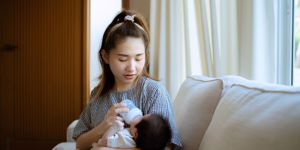You’ve done it mumma! Your baby is finally here. What a relief! Your placenta has been delivered too and you’re now enjoying your rest, cuddled up with your new baby, excited to share the news with the whole family. But what happens before you take them home?
If you’ve seen newborn babies on TV or in films, you’d be forgiven for thinking that they are born all nice and clean. In real life, your newborn is likely to be a bit wrinkled, more purple and covered in a whole manner of fluids and gunk. They might still have a waxy white substance called 'vernix' on their body and fluid, mucus, and blood from the actual birth. They may also be quite hairy! This hair is called 'lanugo' and helps to protect your baby in the womb. It should disappear quite quickly though.
You’ll be encouraged to enjoy skin-to-skin contact with your baby as soon as possible after birth and you can do this even if you have had a caesarean section. It may be the case that your partner is offered the chance to hold the baby against their skin too, as that helps with their bonding.
The First Feed
If it is your wish to do so, you will be supported to initiate breastfeeding during skin-to-skin time. Your midwife can help you with positioning and attachment to minimise the risk of suffering with sore nipples.
If you are formula feeding, you will need to bring pre-made formula with you in your hospital bag. These are sold pre-mixed, so you won't need to mix powder and water on the day. Your midwife and the other staff at the hospital will help you with whatever you need, so don’t be afraid to ask. Your baby will want to feed roughly 8 times in 24 hours, but this may not be evenly spread and varies from baby to baby.
Final Checks
There are a few tests carried out on your baby after their birth, but none of them are painful and your baby won’t remember them! The first is the 'Apgar' test, which is done at one minute and again at five minutes after the birth and again after ten minutes. Your baby will be given a score of 0-10 for breathing, response, heartbeat, colour and muscle tone. Most babies will score between 7 and 10.
The midwife will also measure their weight, length (if you want them to), head circumference, and temperature after delivery. Before you are discharged, a full examination of your baby also takes place, checking their vitals, anus, hips, eyes, and genitals.
There may be additional tests required, such as if your baby was breech at birth, or if the doctor suspects your baby has jaundice. They should also check for tongue tie (particularly if the first feed didn’t go well) and keep checking in with you as to whether they’ve pooed and peed yet. Again, this is routine and nothing to be concerned about, they just want to make sure the baby is perfectly happy and healthy before they send you home!
If at any point you feel overwhelmed or aren’t sure what to do, how to do it, or just need some rest following the birth and your partner has nipped home, the midwives are on-call to help ensure baby is happy and give you a little rest too. They can answer any questions you have.
Once all the checks have been completed on you and your baby, you will be given information on safe sleep guidelines and advised of when your midwife will be popping by to see you at home.
Time to take baby home and start your life as a bigger family!




